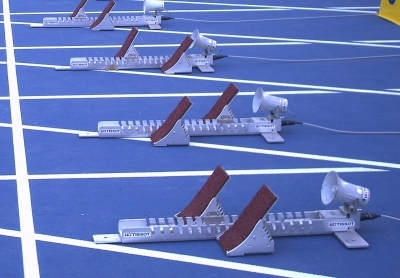
Have you ever been told by your elders that it is better to be quick off the blocks when doing something? An oft-used idiom, someone is quick or slow off the blocks or out of the blocks when they are quick or slow to do something. Similarly, one is first or last off the blocks, when they are the first or last to start doing something. We’ll be discussing starting blocks today, where it is almost always important that an athlete gets quickly off the blocks.
You’ve probably never seen a running race at the highest level where the athletes haven’t used starting blocks. But when you race at school during your sports day, you and your friends wouldn’t have used starting blocks in all likeliness. Even until the 1920s, it wasn’t much different with elite athletes.
Holes for a foothold
A scene from a running race during that era would be way different from how it is these days. In the place of a master of ceremonies announcing the athletes lining up at the starting grid, athletes were provided with trowels at the start of the race. Using these, the athletes then dug holes in the track in order to get a firm foothold. The race would then begin.
While this method did allow for a quicker start than what was normal then, it had its fair share of problems. For one, it wasn’t consistent for all athletes as they dug their own holes. These holes weren’t always stable either and there was also the issue of filling it up for subsequent races. Not to mention, this method was destructive to the track surface. It was these things that led George Thomas Bresnahan to invent what he called a “foot support in his patent. A coach of University of Iowa track teams for more than 27 years before his retirement in 1948, Bresnahan was interested in the science behind sports, apart from the sport itself.
Brenahan invents “foot support”
As a result, he came up with his invention, describing it as “what might be termed a starting block” for a running track. He applied for his patent in 1927 and was awarded the patent on February 5, 1929.
It is obvious that Bresnahan, like so many others involved in track events, realised the importance of the getaway when sprinting. But unlike others, he worked towards improving it, giving an early form of the starting blocks in the process.
Good getaway
Bresnahan, who was an assistant coach of the U.S. Olympic team in 1932 and in charge of the 4x400m relay team that broke the world record, included features in his invention that have remained with starting blocks till this day. He not only made it adjustable to fit the individual’s foot needs, but also provided the ability to change the tilt angle to suit the runners preference. The result was a firmer foothold and a stronger start for any athlete.
It wasn’t adopted immediately though as it was only in 1937 that the International Amateur Athletics Federation (now) International Association of Athletics Federation or IAAF) accepted their use. Ten years after IAAF’s acceptance came the 1948 London Olympics, which saw starting blocks used for the first time at the Olympics in sprint events.
Ever since, there have been frequent iterations on these starting blocks, making them most suitable for the athletes needs. While estimates suggest that athletes save about one-tenth of a second by using starting blocks, they are also used these days to determine false starts. Used in most races of 400m or shorter, these starting blocks allow elite athletes to reach the maximum velocity in the minimum possible time, thereby putting on a spectacle for us spectators.
- Starting blocks these days are not only essential for sprint events, but are also technological aids.
- Based on pressure exerted on these, they can detect athletes’ reaction time to 1,000th of a second. If the reaction time is less than one-tenth of a second, it is considered a false start.
- These blocks also include electronic speakers these days, so that the sound of the gun reaches the ears of the athletes at exactly the same moment.
Picture Credit : Google




